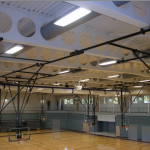Why Steel Is the Perfect Material for Building Bridges
Steel is a versatile building material that’s been used for centuries in various capacities. Because of its inherent strength and durability, it is the ideal material for long-standing structures like bridges. There are approximately 600,000 bridges in the US alone, and about one-third of them were built using a significant amount of steel, including castellated beams.
Versatility, cost-effectiveness, longevity, and sustainability are just some of the characteristics of steel that make it an attractive option to use as a material for bridge-building. However, there are actually more compelling reasons for the use of steel as a bridge material. Let’s explore some of them.
Resilience
Many notable and historic bridges have been built using steel. In fact, some of them are still standing today after more than 100 years since they were first constructed. One good example is the Union Bridge in Waterford, New York, which was originally built as a wooden bridge in 1804. In 1909, it burned down and was reconstructed into a steel bridge that still stands today. Other famous examples are the Golden Gate Bridge, the Brooklyn Bridge, and the Eads Bridge.
With careful maintenance, any steel bridge is sure to stand the test of time. They can prove their resiliency despite being exposed to harsh environmental conditions and extreme events.
Accelerated Construction Schedule
Modern bridge-building techniques involve fabricating parts off-site with geometrically controlled equipment. Once completed, those structural steel parts become ready to erect as soon as they reach the bridge site. The use of castellated beams and structural steel for a bridge project accelerates the construction and can even reduce on-site labor requirements and costs.
Future Modification and Adaptability
Structural steel bridge components can be strengthened and adapted if the need arises. Some modifications you can do with steel bridges include increasing live loadings, installing new live loadings, roadway widenings, and other configurations. This isn’t possible with other materials like stone bridges as they are a more permanent structure.
Long-Span Construction
Steel has the capability of spanning crossings well over 500 feet, usually in the form of plate girders, tied-arches, suspension bridges, cable-stayed bridges, and trusses. Just look at the Golden Gate Bridge. It is easily one of the most recognizable engineering feats ever constructed using steel materials. Controlled fabrication, lighter components, and durability are some of the defining features of steel that make it the ideal material for long-span structures.
Maintainability and Repairability
Any bridge that experiences a lot of traffic will eventually become worn out as time goes on. Steel bridges can be efficiently repaired and remain in serviceable condition without replacing or rebuilding them entirely. Components can be strengthened by adding more material, or they can be removed and replaced without significantly affecting the structural integrity. Through proper maintenance and repair, extending the in-service usefulness of a steel bridge is very much possible.
Conclusion
It’s more evident than ever why steel is used more often on bridge construction sites. With its unique properties and its ability to withstand the test of time, steel made it possible to build structures that would have been unthinkable before the industrial revolution.
You might be wondering, “are there steel beam companies near me offering quality solutions for my construction project?” The answer is C-BEAMS, a proud supplier of innovative structural solutions and products. We are one of the go-to castellated beam suppliers and manufacturers offering versatility, reliability, and economy for all types of floor and roof structures. Contact us today to learn more about our products.






